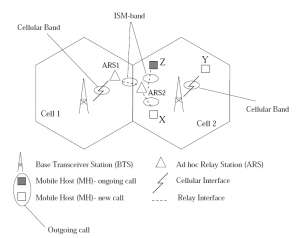With the wide-spread deployment of wireless networks, high data rates can be provided to mobile users in large coverage areas. However, since the bandwidth in a wireless network is limited, efficient allocation of resources (channels) to each cell is crucial. This problem becomes more acute when some cells in the system are congested or “hot”; i.e., when the traffic generated by the subscribers exceeds the capacity of the service provider’s infrastructure. In cellular networks, one solution to the hot spot problem is dynamically balancing the load of the hot cells, i.e., handling the excess traffic of the hot cells by the cooler (non-congested) cells in the network. As part of my PhD studies, an overlay ad hoc relay network over the cellular network (iCAR) is used to achieve dynamic load balancing, coverage extension, and robustness to failures and changes in the environment. We have studied both voice-based and voice and data based cellular networks, using iCAR-one of the first relay-based cellular network architectures.
The key scientific contributions include the following:
- Dynamic load balancing among base stations: developed a unified framework that captures known load-balancing techniques in a single model
- Analysis of iCAR (integrated cellular and ad hoc relay system): congestion relief, resource management, and coverage extension via relays
Selected Publications:
O. K. Tonguz and E. Yanmaz, “The Mathematical Theory of Dynamic Load Balancing in Cellular Networks,” IEEE Transactions on Mobile Computing, vol. 7, no. 12, pp. 1504-1518, Dec. 2008.
E. Yanmaz, O. K. Tonguz, and R. Rajkumar, “Is There an Optimum Dynamic Load Balancing Scheme?,” IEEE Global Telecommunications Conference (GLOBECOM’05), vol. 1, pp. 598-602, Dec. 2005.